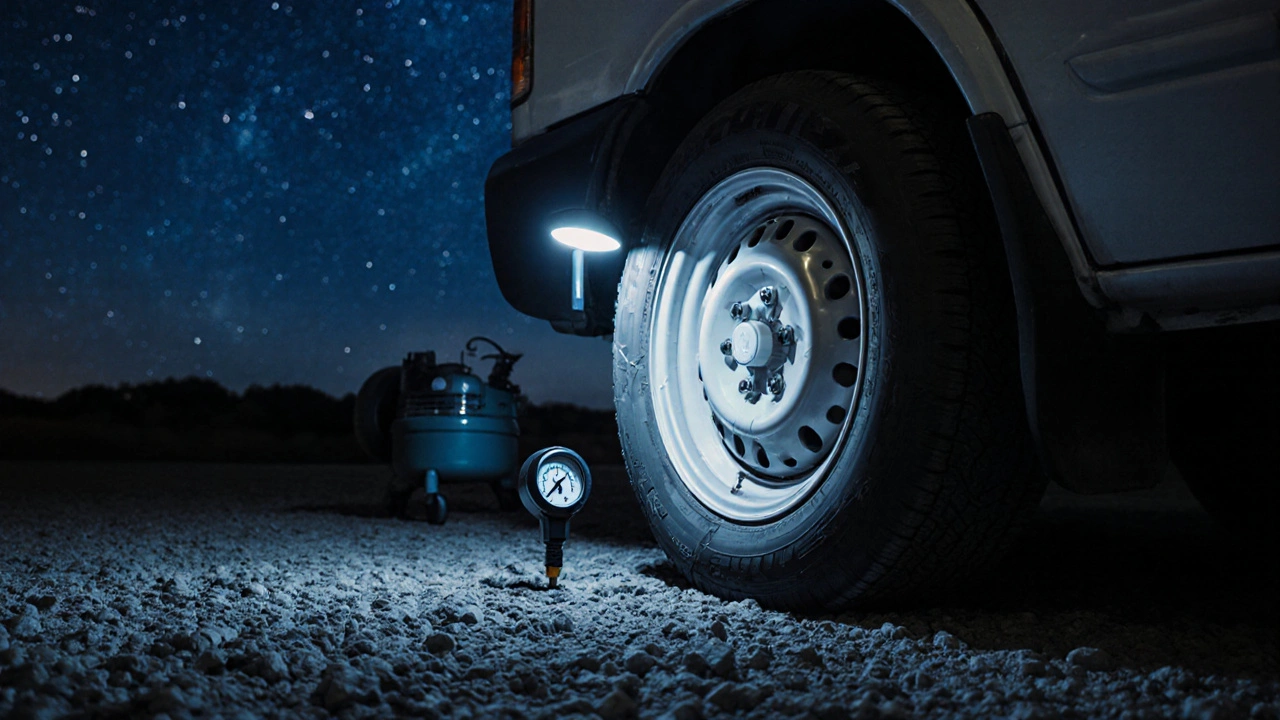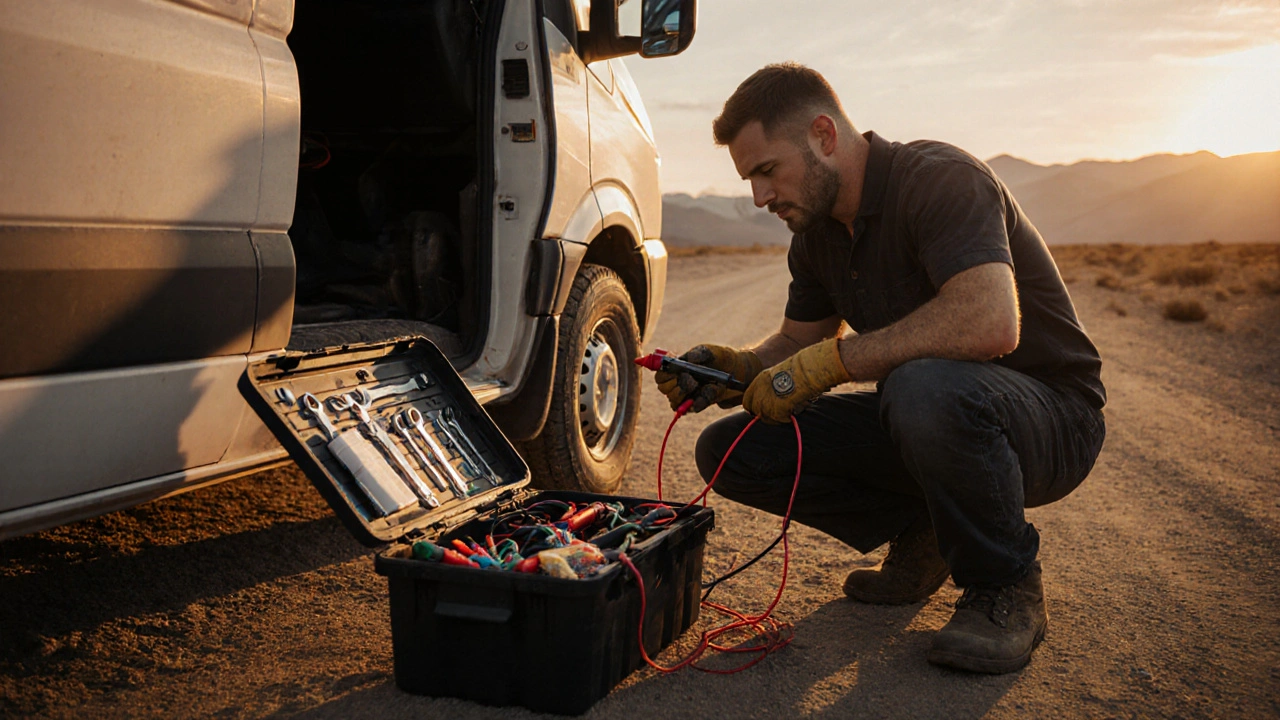Living full-time in a van sounds free and adventurous-until your water pump dies in the middle of nowhere, your fridge stops cooling on a 90-degree day, or your battery bank drains before sunrise. Van life isn’t just about scenic views and coffee in the mountains. It’s about knowing how to fix things when you’re 200 miles from the nearest town. The difference between a smooth trip and a stranded nightmare? Regular maintenance and knowing what to do when things break.
What Breaks Most in a Van Conversion?
Not every van is the same, but certain systems fail more often than others. Based on real-world reports from over 300 van lifers surveyed in 2024, here’s what breaks the most:
- Water pumps - 68% of van owners report failure within the first 18 months. Cheap pumps bought online often die under constant use.
- 12V battery systems - Poor wiring, undersized cables, or mismatched chargers cause 52% of electrical issues.
- Refrigerators - Absorption fridges (like Dometic CFX3) fail when not leveled or if ventilation is blocked.
- Propane lines and regulators - Cracks and leaks are common after years of vibration and temperature swings.
- Tires and wheel bearings - Van tires wear faster than car tires due to heavier loads and rough roads.
These aren’t rare glitches. They’re predictable. The key isn’t avoiding them-it’s preparing for them.
Essential Tools for On-the-Road Repairs
You don’t need a full workshop. But you do need the right tools to handle the top 5 failures. Here’s what fits in a 12x12x6 inch toolbox:
- 12V multimeter - For testing batteries, fuses, and wiring. Get one with a continuity beeper.
- Set of metric wrenches and sockets - Most van parts use metric sizes. Include a torque wrench for wheel nuts.
- Heavy-duty zip ties (20+) - Fix loose hoses, wires, or panels in seconds.
- Water pump diaphragm kit - For common 12V pumps like Shurflo or Jabsco. Replacing the diaphragm costs $12 and takes 15 minutes.
- Propane leak detector spray - Mix dish soap and water. Spray it on fittings. Bubbles mean a leak.
- Extra fuses (5A, 10A, 15A, 20A) - Most electrical failures are just blown fuses.
- Self-amalgamating tape - Waterproofs electrical connections without heat.
- Portable air compressor - For tire pressure checks and minor leaks.
Keep this kit in an easily accessible spot-not tucked under the bed. You’ll need it at 2 a.m. when your fridge stops working.
How to Fix a Dead Water Pump
Your sink drips. Your shower won’t turn on. The pump hums but doesn’t push water. That’s usually a failed diaphragm.
- Turn off the 12V power to the pump.
- Locate the pump (usually under the sink or in a storage compartment).
- Unscrew the inlet and outlet hoses. Drain any remaining water.
- Remove the four screws holding the pump housing.
- Take out the old diaphragm. It’s a thin rubber disc with a metal plate.
- Install the new one. Make sure the metal plate faces the motor side.
- Reassemble, reconnect hoses, and turn the power back on.
- Run water for 30 seconds to purge air.
Most people buy a new pump for $150. Replacing the diaphragm costs $12 and saves you hours of waiting for parts. Keep two spares in your kit.

Diagnosing Battery Problems Without a Pro
A dead battery is the #1 reason vans get stuck. But it’s rarely the battery’s fault-it’s the system around it.
Use your multimeter:
- Turn off all power loads (lights, fridge, inverter).
- Set the multimeter to DC voltage.
- Touch the red probe to the positive terminal, black to negative.
Here’s what the reading means:
- 12.6V or higher - Fully charged
- 12.4V - 75% charged
- 12.2V - 50% charged
- 12.0V or lower - Deeply discharged. Risk of permanent damage.
If your battery reads below 12.0V after sitting for 12 hours, something is draining it. Common culprits:
- LED lights left on
- Bluetooth speakers or phone chargers plugged in
- Bad isolator or charger
- Old battery that can’t hold charge
Install a battery monitor (like Victron BMV-712) to track usage. It shows you exactly how much power you’re using-and if you’re overdrawn.
Why Your Fridge Isn’t Cooling (And How to Fix It)
If your fridge runs but doesn’t get cold, it’s not broken. It’s misused.
Most van fridges are absorption models. They need:
- Level ground - Even a 5-degree tilt stops cooling. Use a small bubble level on the fridge.
- Good airflow - The back vent must have 6+ inches of clearance. Dust buildup blocks heat dissipation.
- Proper propane flow - If the flame is yellow or flickering, the regulator is clogged. Clean it with compressed air.
- Stable power - Voltage drops below 11.5V and the fridge switches to propane. If propane fails, it shuts off.
Check the flame at night with a flashlight. It should be steady and blue. If it’s orange or weak, clean the burner tube with a pipe cleaner. Don’t use water-it leaves residue.
Preventing Tire Blowouts on Long Trips
Van tires carry 30-40% more weight than car tires. They also sit longer without movement. That’s a recipe for sidewall cracks and blowouts.
Do this every 500 miles:
- Check tire pressure with a digital gauge. Set to manufacturer’s max load rating-not the car’s recommendation.
- Look for cracks on the sidewalls. If you see more than 3 deep lines, replace the tire.
- Spin each wheel by hand. Listen for grinding. That’s a failing bearing.
- Check lug nuts. Tighten to 85-95 lb-ft torque. Loose nuts cause wheel wobble and heat buildup.
Replace tires every 4 years, even if they look fine. Rubber degrades from UV exposure and heat, not just tread wear.

When to Call a Pro (And When to Keep Going)
Some fixes are DIY. Others aren’t worth the risk.
Call a mechanic if:
- Brakes feel spongy or squeal
- Engine overheats or loses power
- Transmission slips or makes grinding noises
- Steering feels loose or pulls to one side
You can handle:
- Water pump diaphragm
- Blown fuse
- Loose wire connection
- Propane leak (if you can isolate and seal it)
- Tire pressure and minor air leaks
Don’t guess with brakes or steering. A $200 repair on the side of the road is better than a $20,000 hospital bill.
Build a Maintenance Schedule (No More Guessing)
Keep a simple log. Write it in a notebook or use a free app like VanLife Tracker.
Every 1,000 miles:
- Check tire pressure and wear
- Inspect battery terminals for corrosion
- Test all lights and switches
- Check fridge ventilation and flame
Every 5,000 miles:
- Replace water pump diaphragm
- Flush water system with vinegar solution
- Inspect propane lines for cracks
- Check wheel bearings (lift wheel, spin, feel for play)
Every 12 months:
- Replace all fuses (even if they’re good)
- Test inverter and charger output
- Check roof seals for leaks
- Replace tires if over 4 years old
Stick to the schedule. Van life doesn’t reward spontaneity-it rewards consistency.
Final Tip: Always Have a Backup Plan
Even the best-maintained van can fail. Always carry:
- At least 5 gallons of water in jugs
- Two spare 12V batteries (or a portable power station)
- A thermal blanket and warm clothes
- A paper map and offline GPS (like Gaia GPS)
- A list of nearby RV repair shops (downloaded ahead of time)
Van life isn’t about avoiding breakdowns. It’s about knowing you can handle them. The more you prep, the more freedom you actually have.
How often should I replace my van’s water pump?
You don’t need to replace the whole pump unless it’s cracked or the motor burns out. Most 12V pumps last 3-5 years, but the diaphragm inside fails every 12-18 months. Replace just the diaphragm kit every year or after 10,000 miles of use. It’s a $12 fix that takes 15 minutes.
Can I use a car battery in my van conversion?
No. Car batteries are designed for short bursts of power to start an engine. Van systems need deep-cycle batteries that can be drained 50-80% daily without damage. Use AGM or lithium iron phosphate (LiFePO4) batteries rated for deep discharge. A car battery will die in 3-6 months under van use.
Why does my fridge work on shore power but not on battery?
Most van fridges switch to propane when battery voltage drops below 11.5V. If it’s not cooling on battery, your voltage is too low. Check your battery charge level, wiring connections, and inverter efficiency. A bad inverter can drop voltage even if the battery is fine. Use a multimeter to measure voltage at the fridge’s power input-not just at the battery.
What’s the best way to clean a propane line?
Turn off the propane tank first. Disconnect the line and blow it out with compressed air. If you don’t have air, use a pipe cleaner to gently scrub the inside. Never use water or soap-it leaves moisture that causes corrosion. Reassemble and test with soapy water to check for leaks before using.
Is it safe to drive with a cracked tire sidewall?
No. A cracked sidewall means the internal structure is compromised. It can fail without warning, especially at highway speeds or under heavy load. Replace the tire immediately. Even small cracks that look cosmetic can lead to blowouts. Van tires carry more weight than car tires-there’s no room for risk.


Comments
Gabby Love
Diaphragm kits are a game-changer. I replaced mine last winter in the Rockies and saved $150 and a whole day of waiting for a part to ship. Keep two spares. Seriously.
Also, always test your pump with the hoses disconnected first. Air pockets are silent killers.
November 7, 2025 at 01:09
Jen Kay
Let’s be real-van life isn’t about the Instagram posts. It’s about the 3 a.m. fixes with a headlamp and a prayer.
And yes, your fridge won’t work if it’s tilted like a drunk sloth. I learned that the hard way in Moab.
November 8, 2025 at 17:18
Michael Thomas
Use a car battery? That’s why Americans die in vans. Get a deep cycle or go home.
Also, propane leaks aren’t ‘minor.’ They’re death traps. Stop being lazy.
November 9, 2025 at 06:21
Abert Canada
Had a water pump die in Banff last year. Took me 20 minutes to swap the diaphragm with the kit from my toolbox. Saved me from calling a tow truck in the snow.
Pro tip: label your spare diaphragms with the date. Rubber degrades even in the dark.
Also, never trust a cheap multimeter. I bought a $15 one off Amazon-it showed 12.6V when the battery was dead. Bought a Fluke after that. Worth every penny.
November 9, 2025 at 09:49
Xavier Lévesque
Yup. Tires on vans are just time bombs with tread.
I drove 1,200 miles on a tire with one crack. Thought I was fine. Turned out I was just lucky.
Now I check them like I check my ex’s Instagram. Every. Single. Time.
November 9, 2025 at 17:29
Thabo mangena
It is of paramount importance to maintain a disciplined regimen of vehicle upkeep, particularly when traversing remote terrains. Negligence in this domain may result in catastrophic consequences, including but not limited to, loss of life, property, and dignity. I commend the author for this meticulously structured guide. One must always adhere to the prescribed intervals for maintenance, as spontaneity is the antithesis of safety in mobile living.
November 11, 2025 at 16:47
Karl Fisher
Wow. This is basically a 5,000-word TED Talk on how to not die in your van.
I love it. I’m printing this out and framing it next to my yoga mat and my artisanal kombucha.
Also, I just replaced my fridge with a Yeti 1500. Now I just chill. Literally. And emotionally. It’s a vibe.
November 11, 2025 at 21:41
Buddy Faith
They say water pump diaphragm every year but nobody tells you the real truth
the whole pump is trash
buy a Shurflo 4048 and forget it
and stop using propane
it’s a death trap
get electric fridge
and get lithium
everything else is a scam
November 12, 2025 at 15:08
Scott Perlman
Check your tires. Check your battery. Keep your tools close.
That’s it. You got this.
And yeah the diaphragm thing works. I did it twice.
November 14, 2025 at 09:03
Sandi Johnson
Oh so now we’re all van mechanics? Cool. I just drive and hope.
Also, my fridge works fine on battery. Probably because I’m a wizard.
Or maybe the gods of 12V are just kind to me today.
November 16, 2025 at 06:43
Eva Monhaut
I used to think van life was about sunrises and mountain views. Then my water pump died in the Mojave at 2 a.m. with a scorpion on my boot.
Turns out the real magic isn’t the view-it’s the zip ties, the multimeter, and the quiet confidence that comes from knowing you can fix it.
This guide? It’s not a checklist. It’s a lifeline. Thank you.
November 17, 2025 at 03:05
mark nine
Pro tip: always carry a spare fuse and a pen
write the date on it
and stick it to the fuse box
so you don’t forget
also the soapy water leak test works better than any fancy gadget
trust me
November 18, 2025 at 11:12
Tony Smith
It is truly admirable to see such a comprehensive and methodical approach to mobile living. While some may dismiss these practices as overly cautious, I assert that they represent the very essence of responsible autonomy. One must not confuse convenience with competence. The van is not a toy. It is a vessel of survival. Thank you for this invaluable contribution to the community.
November 20, 2025 at 03:03
Rakesh Kumar
Bro I just got my first van and I thought I was ready
then my fridge died in the desert and I cried
then I read this and I cried again but this time from relief
thank you for writing this like a real human
not some corporate robot
I’m printing this and taping it to my dashboard
next stop: Patagonia
November 21, 2025 at 17:41